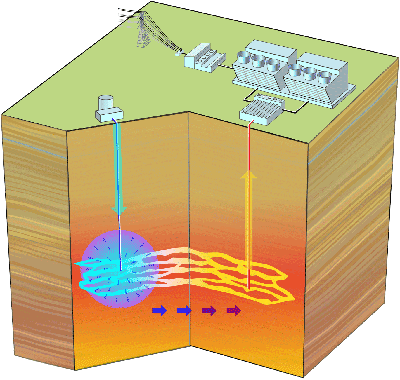Large Scale Geothermal Power - Could it Work?
Geothermal power isn’t a new idea but
researchers in Spain are thinking about the “Big Picture” and their work
could have significant implications for the future of the global energy
landscape.
You might remember a write-up in
Resilient Strategies last year where I explained how home geothermal
systems work to keep the average home comfortable year round by pumping
water through a network of pipes located a few feet below the ground.
The reason this works is because despite
sometimes radical temperature fluctuations on the surface of the Earth,
if you dig down a few feet the ground maintains a consistent temperature
around 55°F. This keeps the home cool in the summer and using a heat
collector, amplifies the heat to keep the home warm in the winter.
The research being done at the University
of Valladolid in Spain is based on geothermal principles but is nothing
like the home systems described above.
Let me start with a question: Do you know how hot the center of the Earth is?
Believe it or not, it’s almost as hot as the surface of the Sun.
Another question: Why aren’t we using this energy to mitigate the growing energy crisis?
With any luck, that may change soon.
Enhanced Geothermal Systems
Rather than dig only a few feet under the
surface to access the consistent temperatures commonly leveraged for
residential geothermal systems, an Enhanced Geothermal System (EGS) digs
thousands of meters into the ground to capture some of the intense heat
that escapes from the Earth’s core.
This heat is used to boil water, which
creates steam and ultimately drives turbines that generate power. Pretty
much the same thing as current power plants except EGSs don’t need
fossil fuels or radioactive fuel rods to make it happen.
If implemented successfully, we could
generate power 24 hours a day without concerns about the rising costs of
fossil fuels or the hazards associated with nuclear power plants.

And we’re not talking about a little bit
of power either. Current estimates demonstrate that an EGS in Spain
could produce up to 700 Gigawatts of power.
To put that into perspective, the U.S.
generates approximately 1,000 Gigawatts of power during peak summer
usage. A little over 700 Gigawatts of that power comes from coal-fired
power plants.
In other words, a single EGS with similar
capacity as the one proposed in Spain could eliminate fossil-fuel based
power generation in the United States practically overnight.
Anyway, back across the ocean to Spain.
The Iberian Peninsula has multiple areas where temperatures reach
sufficient values at relatively shallow depths. Oh, by the way,
relatively shallow means 3,000 – 10,000 meters below the surface.
That may seem extraordinarily deep but
keep in mind that many oil holes are drilled in this depth range so the
technology already exists to make it happen.
Perhaps the only real obstacle the modern
EGS faces is that it is essentially a form of fracking – officially
known as hydraulic fracturing. Despite the massive amounts of natural
gas our country is now harvesting thanks to this process, there are some
serious side effects associated with traditional fracking such as
ground water contamination.
The difference when harnessing geothermal
energy is that the pressures are lower, the chemicals are not as
dangerous and the pressurized water would be injected into hot rocks
below the surface – not near natural water supplies.
But to an environmentalist, fracking is
fracking so I would expect EGS construction to face many of the same
obstacles faced by natural gas companies using fracking to extract fuel
from shale beds below the surface.
Even if the EGS weren’t approved, there
is another way to use geothermal power although the results are not
nearly as impressive. Researchers have determined that the Iberian
Peninsula could generate approximately 3.2 Gigawatts of power just by
using the heat that reaches the Earth’s surface naturally.
That means no drilling and no injecting water into the ground.
3.2 Gigawatts may not seem like a lot
(certainly not when compared to 700 Gigawatts), but that is the
equivalent of three nuclear power plants. Even that would offer a much
more sustainable solution than our current energy infrastructure.
By the way, the graphic below shows the
temperatures below the surface within the United States. Anything over
150°C can be used to generate power using an EGS and that includes most
areas of the country so EGSs are a feasible alternative in this country
as well.

As interesting and potentially
ground-breaking (pun intended) as this idea is, I’m certain it’s a long
road ahead – especially in the United States. I recently wrote about
Ohio’s decision to freeze current alternative energy requirements which I
surmise has a lot to do with lobbyists associated with the massive
fossil fuel industry in the state.
Why would an idea like this be any
different? If I were a fossil fuel mogul, I’d be shivering in my boots
to think that a single new technology could take out all the coal-fired
power plants in the country simultaneously.
So, as usual, it comes down to government
inefficiency and the unwillingness to change politicians so proudly
display like an American Flag pin on the lapel of their jacket. All we
can hope for at this point is that the project is a success in Spain.
Verifiable results are much more difficult to argue with than a good
idea and only time will tell.
To your resilience,
Paul Clarke
ResilientCommunities.com
No comments:
Post a Comment